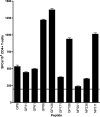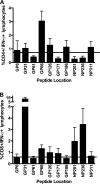Lymphocytic choriomeningitis virus infection yields overlapping CD4+ and CD8+ T-cell responses
- PMID: 18829752
- PMCID: PMC2583689
- DOI: 10.1128/JVI.00435-08
Lymphocytic choriomeningitis virus infection yields overlapping CD4+ and CD8+ T-cell responses
Abstract
Activation of CD4(+) T cells helps establish and sustain other immune responses. We have previously shown that responses against a broad set of nine CD4(+) T-cell epitopes were present in the setting of lymphocytic choriomeningitis virus (LCMV) Armstrong infection in the context of H-2(d). This is quite disparate to the H-2(b) setting, where only two epitopes have been identified. We were interested in determining whether a broad set of responses was unique to H-2(d) or whether additional CD4(+) T-cell epitopes could be identified in the setting of the H-2(b) background. To pursue this question, we infected C57BL/6 mice with LCMV Armstrong and determined the repertoire of CD4(+) T-cell responses using overlapping 15-mer peptides corresponding to the LCMV Armstrong sequence. We confirmed positive responses by intracellular cytokine staining and major histocompatibility complex (MHC)-peptide binding assays. A broad repertoire of responses was identified, consisting of six epitopes. These epitopes originate from the nucleoprotein (NP) and glycoprotein (GP). Out of the six newly identified CD4(+) epitopes, four of them also stimulate CD8(+) T cells in a statistically significant manner. Furthermore, we assessed these CD4(+) T-cell responses during the memory phase of LCMV Armstrong infection and after infection with a chronic strain of LCMV and determined that a subset of the responses could be detected under these different conditions. This is the first example of a broad repertoire of shared epitopes between CD4(+) and CD8(+) T cells in the context of viral infection. These findings demonstrate that immunodominance is a complex phenomenon in the context of helper responses.
Figures




Similar articles
-
Chronic lymphocytic choriomeningitis virus infection actively down-regulates CD4+ T cell responses directed against a broad range of epitopes.J Immunol. 2007 Jul 15;179(2):1058-67. doi: 10.4049/jimmunol.179.2.1058. J Immunol. 2007. PMID: 17617598
-
CD4+ T cells are required to sustain CD8+ cytotoxic T-cell responses during chronic viral infection.J Virol. 1994 Dec;68(12):8056-63. doi: 10.1128/JVI.68.12.8056-8063.1994. J Virol. 1994. PMID: 7966595 Free PMC article.
-
Independent regulation of lymphocytic choriomeningitis virus-specific T cell memory pools: relative stability of CD4 memory under conditions of CD8 memory T cell loss.J Immunol. 2001 Feb 1;166(3):1554-61. doi: 10.4049/jimmunol.166.3.1554. J Immunol. 2001. PMID: 11160196
-
Role of virus and host variables in virus persistence or immunopathological disease caused by a non-cytolytic virus.J Gen Virol. 1995 Feb;76 ( Pt 2):381-91. doi: 10.1099/0022-1317-76-2-381. J Gen Virol. 1995. PMID: 7531218
-
Evidence for an underlying CD4 helper and CD8 T-cell defect in B-cell-deficient mice: failure to clear persistent virus infection after adoptive immunotherapy with virus-specific memory cells from muMT/muMT mice.J Virol. 1998 Nov;72(11):9208-16. doi: 10.1128/JVI.72.11.9208-9216.1998. J Virol. 1998. PMID: 9765468 Free PMC article.
Cited by
-
Vaccine-elicited CD4 T cells induce immunopathology after chronic LCMV infection.Science. 2015 Jan 16;347(6219):278-82. doi: 10.1126/science.aaa2148. Science. 2015. PMID: 25593185 Free PMC article.
-
Both positive and negative effects on immune responses by expression of a second class II MHC molecule.Mol Immunol. 2014 Nov;62(1):199-208. doi: 10.1016/j.molimm.2014.06.024. Epub 2014 Jul 10. Mol Immunol. 2014. PMID: 25016574 Free PMC article.
-
Prostate Cancer Immunotherapy: Exploiting the HLA Class II Pathway in Vaccine Design.J Clin Cell Immunol. 2015 Aug;6(4):351. doi: 10.4172/2155-9899.1000351. Epub 2015 Aug 26. J Clin Cell Immunol. 2015. PMID: 26807308 Free PMC article.
-
Differential T cell responses to residual viral antigen prolong CD4+ T cell contraction following the resolution of infection.J Immunol. 2013 Dec 1;191(11):5655-68. doi: 10.4049/jimmunol.1301215. Epub 2013 Oct 21. J Immunol. 2013. PMID: 24146043 Free PMC article.
-
B cells are sufficient to prime the dominant CD4+ Tfh response to Plasmodium infection.J Exp Med. 2020 Feb 3;217(2):e20190849. doi: 10.1084/jem.20190849. J Exp Med. 2020. PMID: 31748243 Free PMC article.
References
-
- Bailey, J., J. N. Blankson, M. Wind-Rotolo, and R. F. Siliciano. 2004. Mechanisms of HIV-1 escape from immune responses and antiretroviral drugs. Curr. Opin. Immunol. 16470-476. - PubMed
-
- Barber, D. L., E. J. Wherry, D. Masopust, B. Zhu, J. P. Allison, A. H. Sharpe, G. J. Freeman, and R. Ahmed. 2006. Restoring function in exhausted CD8 T cells during chronic viral infection. Nature 439682-687. - PubMed
-
- Berger, D. P., D. Homann, and M. B. A. Oldstone. 2000. Defining parameters for successful immunocytotherapy of persistent viral infection. Virology 266257-263. - PubMed
Publication types
MeSH terms
Substances
Grants and funding
LinkOut - more resources
Full Text Sources
Molecular Biology Databases
Research Materials
Miscellaneous

